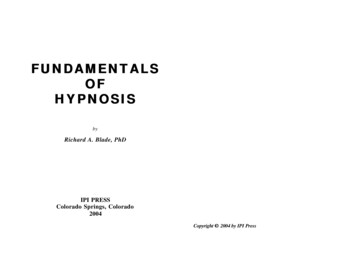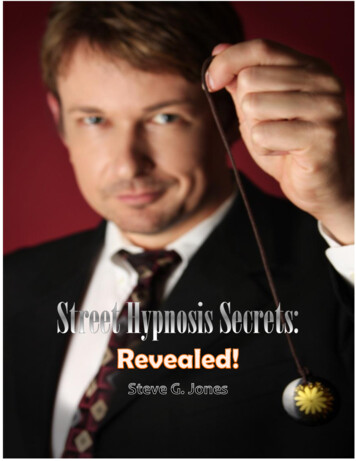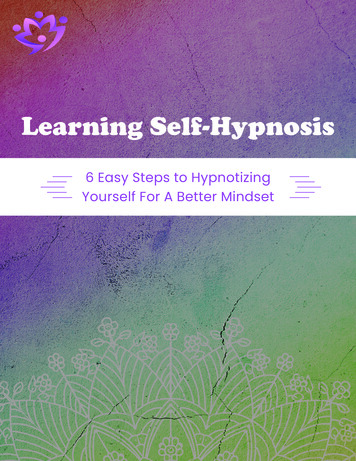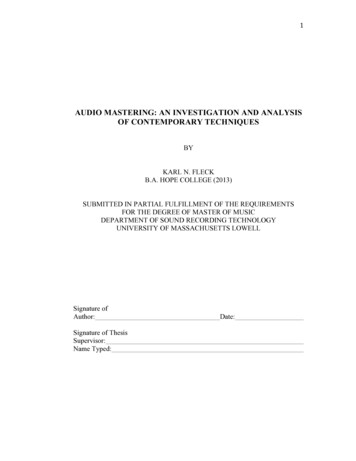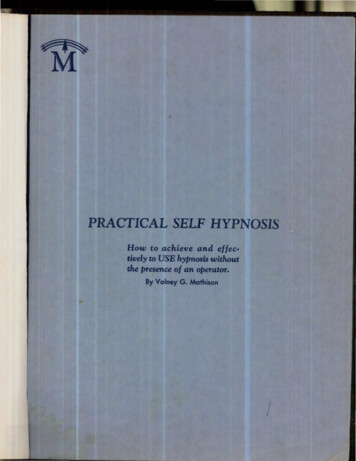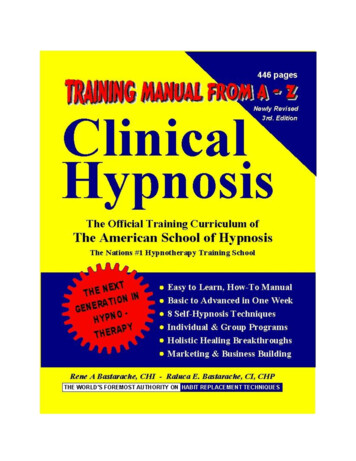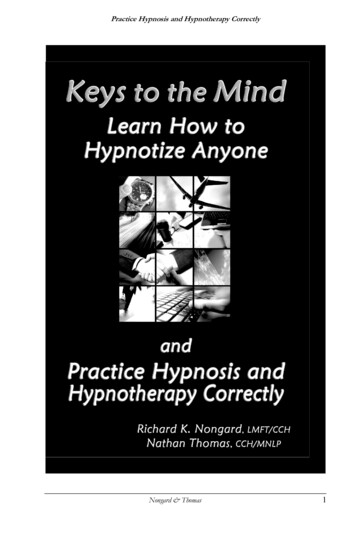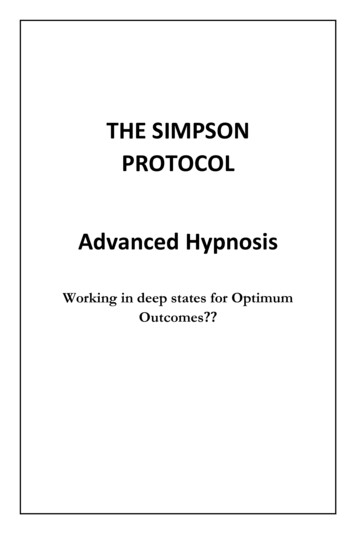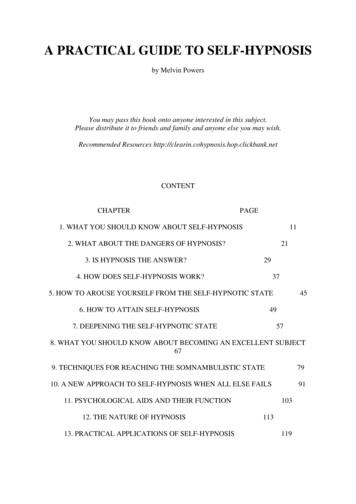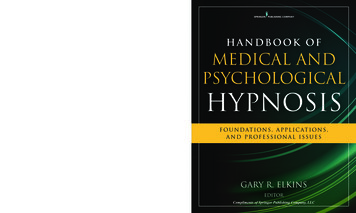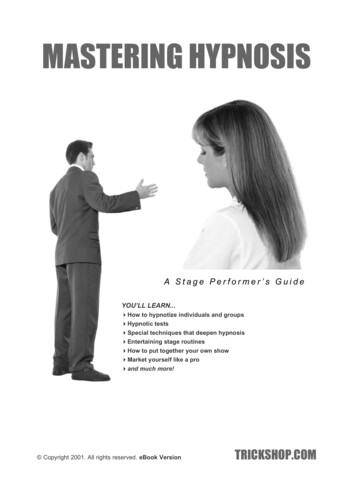
Transcription
MASTERING HYPNOSISA Stage Performer’s GuideYOU’LL LEARN.4How to hypnotize individuals and groups4Hypnotic tests4Special techniques that deepen hypnosis4Entertaining stage routines4How to put together your own show4Market yourself like a pro4and much more! Copyright 2001. All rights reserved. eBook VersionTRICKSHOP.COM
MASTERING HYPNOSISA Stage Performer’s Guide
MASTERING HYPNOSIS A Stage Performer’s GuideTABLE OF CONTENTSCHAPTER ONE: AN INTRODUCTION TO HYPNOSIS . . . . . . . . . . . . . . . . . . . . . . . . 7CHAPTER TWO: BASIC HYPNOTIC TECHNIQUE. . . . . . . . . . . . . . . . . . . . . . . . . . . 17CHAPTER THREE: ADVANCED HYPNOTIC CONCEPTS AND TECHNIQUES . . . . 27CHAPTER FOUR: DEEP TRANCE PHENOMENA AND TESTS . . . . . . . . . . . . . . . . 35CHAPTER FIVE: ELIMINATION TESTS . . . . . . . . . . . . . . . . . . . . . . . . . . . . . . . . . . . 47CHAPTER SIX: PLANNING THE SHOW . . . . . . . . . . . . . . . . . . . . . . . . . . . . . . . . . . . 51CHAPTER SEVEN: A SUBJECT’S PERSPECTIVE . . . . . . . . . . . . . . . . . . . . . . . . . . 73CHAPTER EIGHT: MARKETING YOURSELF. . . . . . . . . . . . . . . . . . . . . . . . . . . . . . . 87 Copyright 2001 by TRICKSHOP.COM INC.All rights reserved. No part of this book may be reproduced or transmitted in any form by any means, electronic, mechanical, photocopying, recording, or otherwise, without the express and prior writtenconsent of the publisher.Other copyrights are the property of their respective owners.eBook Version. Not for resale. If you purchased a printed copy ofthis document, please report it to “sales@trickshop.com”. Reward forinformation leading to the arrest and conviction of the violator.TRICKSHOP.COM INC.P.O. Box 68441Schaumburg, IL .comDigitally printed in the United States of America4
FOREWORDIf you’re interested in mastering the art and science of stage hypnotism,we’re confident you’ll find no better guide available today. Written withthe experienced stage performer in mind, this insightful, how-to guide willteach you everything you need to know to succeed in this fascinatingfield–from how to hypnotize both individuals and groups to the closelyguarded professional techniques used to deepen hypnosis and maximizethe power of hypnotic suggestions. What’s more, you’ll learn how toperform many of the same classic tests and entertaining stage routinesused by top professionals worldwide, as well as get in-depth advice onputting together and marketing your own show. It’s all here.Good Luck!MASTERING HYPNOSIS A Stage Performer’s Guideis a TRICKSHOP.COM Publication5
Chapter One1AN INTRODUCTION TO HYPNOSIS7
MASTERING HYPNOSIS A Stage Performer’s GuideChapter OneAN INTRODUCTION TO HYPNOSISWHAT IS HYPNOSIS?Simply put, hypnosis is an altered state of consciousness characterized byheightened susceptibility to suggestion. Under hypnosis, suggestions bypass thecritical faculties of normal consciousness and directly enter the subconsciousmind–where “if accepted,” they are acted upon. The deeper the level of hypnosis, the greater the subject’s suggestibility.This entire process is based upon the fact that while our conscious thoughtprocesses use inductive reasoning, our subconscious uses only deductivereasoning. Once a suggestion is accepted by the subconscious, it is automatically transformed into reality. It does not matter if the suggestion originates froman internal source (ie. self-hypnosis) or an external one (the operator). Indeed,the distinction between autosuggestion and heterosuggestion is considered tobe both arbitrary and superficial.SCOPE OF HYPNOTIC PHENOMENAThe wide range of phenomena possible with hypnosis was best summedup many years ago by Dr. Bernard Hollander, M.D., in his book, “Hypnotismand Suggestion in Daily Life, Education, and Medical Practice.” His observationsare as relevant today, as when his book was first written. Here they are in Dr.Hollander’s own words:In response to your direct and specific suggestions, your subject maybe rendered happy and gay, or sad and dejected, angry or pleased, liberalor stingy, proud or humble, pugnacious or pacific, bold or timid, hopeful ordespondent, insolent or respectful. He may be made to sing, to shout, to laugh,to weep, to act, to dance, to shoot, to fish, to preach, to pray, to recite abeautiful poem or to excogitate a profound argument.The expression of the subject during these responses while in hypnosis is8
Chapter One A N I N T R O D U C T I O N T O H Y P N O S I Smost important as its very earnestness is profound in its appeal. The attitudesand gestures are equal to, or surpassing, the best efforts of the most accomplished actor, although the hypnotized subject may actually be a person oflimited intellectual cultivation, and show no particular talent for acting or mimicryin the waking state.The hypnotized subject is not acting a part in the ordinary sense of the word.He believes himself to be the actual personality suggested. The subject willimpersonate to perfection any suggested character with which he is familiar.One of the most striking and important peculiarities of the subconsciousmind, as distinguished from the conscious, consists in its prodigious memory.In all degrees of the hypnotic sleep, this exaltation of the memory is one of themost pronounced of the attendant phenomena.One of the remarkable effects of hypnotism is this recollection of circumstances and the revival of impressions long since past, the images of whichhave been completely lost to ordinary memory, and which are not recoverablein the normal state of mind. All the sensations which we have ever experiencedhave left behind them traces in the brain, so slight as to be intangible andimperceptible under ordinary circumstances, but hypnotic suggestion, addressing itself to the unconscious (or subconscious) side of the mind, and such beingthe storehouse of memories can bring into recall these otherwise lost memoriesat the command of the operator. Everything learned in normal life can beremembered in hypnosis, even when apparently it has long been forgotten.Of course, false memories can also be suggested, as for example whenyou say to a subject, “You remember we drove to Richmond yesterday.” Thesuggestion will take effect and he will at once begin to relate all that he believeswe did in Richmond. This is an example of a retroactive positive hallucination,because the subject believes that he experienced something that really neveroccurred.Memory may also be obliterated. Nothing is easier than to make the subjectforget his name and condition in life. This is one of the suggestions which mostpromptly succeed, even with a very new subject. The subject may forget wholeperiods of his life at the suggestion of the hypnotizer.9
MASTERING HYPNOSIS A Stage Performer’s GuideSense delusions are likewise common in hypnosis; either as hallucinationsor illusions. An illusion is the false interpretation of an existing external object,as, for instance, when a chair is taken for a lion, a broomstick for a beautifulwoman, a noise in the street for orchestra music, etc. An hallucination is theperception of an object which does not exist as for instance when you say toyour subject, “Sit down in this armchair” where there is really no chair at all;yet the hallucination is so perfect that he does put himself in exactly the sameattitude as if he were sitting in a real chair, only if you ask him after a time,“Are you comfortable?” he may reply, ‘Not particularly,’ and ask for a chair that ismore comfortable. It seems incredible that an hallucination could be so real thata person would assume an attitude so strained, but it is so.“Suggest to a person that a swarm of bees are buzzing about him; he willnot only see and hear them, but he will go through violent antics to beat themoff. Or tell a person that there are rats in the room, and the word will take upa train of imagery in the subject’s brain which is immediately projected outwardin an expressive display of appropriate gestures of aversion and correspondingmovements of avoidance. The fear depicted on the face of a subject when hebelieves he is about to be attacked by a tiger is more impressive. Editor’s Note:Always avoid any experiments involving disagreeable or dangerous situations.Hallucinations of all the senses and delusions of every conceivable kind caneasily be suggested to a good subject. Just how real these effects are to thesubject is evidenced in experiments where the image of the hallucination hasbeen caused to double by a prism or mirror, magnified by a lens, and in manyother ways behave optically like a real object.In suggesting an hallucination, say that of a bird, the suggested approachof the object causes contraction of the pupil, and vice versa. At the same time,there is often convergence of the axis of the eyes, as if a real object werepresent.Subjects will eat a potato for a peach, or drink a cup of vinegar for aglass of champagne. He may be thrown into a state of intoxication by beingcaused to drink a glass of water under the impression that it is gin, or hemay be restored to sobriety by the administration of gin under the guise of anantidote for drunkenness. In these cases, the expression of the face induced10
Chapter One A N I N T R O D U C T I O N T O H Y P N O S I Sby the suggested perception corresponds so perfectly that a better effect wouldscarcely be produced if the real article were used.Various physiological effects can be produced in the state of hypnosis. Asubject can be caused to weep and shed tears on one side of the face andlaugh with the other. The pulse can be quickened or retarded, respiration slowedor accelerated, or temporarily arrested, and perspiration can be produced–all bysuggestion. Even the temperature can be affected. Thus it has been observedthat is a subject is told he has a high fever his pulse will become rapid, hisface flushed, and and his temperature increased. Or, if a person is told thathe is standing on ice he feels cold at once. He trembles, his teeth chatter,he wraps himself up in his coat. “Gooseskin” [goose bumps] can be producedby the suggestion of a cold bath. Hunger and thirst can be created, and otherfunctions increased or retarded.The mind can be so concentrated upon a physiological process as tostimulate that process to normal activity, so as to produce curative effects,and even to super-abundant activity, so as to produce pathological effects ordisease. For instance, a blister can be caused on a sound and healthy skin byapplying a postage stamp and suggesting that it it a strong mustard plaster; orplacing upon the skin a key or coin with the suggestion that after waking , ablister will appear at the spot where the key or coin had been placed, and ofcorresponding size and shape. The key or coin is then removed and the patientawakened, having no conscious knowledge of the suggestion given, but at theappointed time the blister appears.On the other hand, blisters and burns have been annulled by suggestion.Mere local redness of the skin is easily produced by suggestion, and can beseen to appear in a few minutes by watching the subject.Naturally, several organs can be influenced by suggestion at the same time.Tell someone, “Here is a rose.” At once your subject not only sees, but feelsand also smells the rose. The suggestion here affects sight, feeling and smellat the same time.When the delusion is positive, the hypnotic believes he sees what does notexist; when it’s negative, he fails to recognize the presence of an object reallyplaced before him. An excellent experiment is to suggest to the subject that11
MASTERING HYPNOSIS A Stage Performer’s Guideon awakening he will not be able to see you, although you will remain in theroom so he can feel and hear you, and although he will see everybody else.The subject on being awakened can hear and feel you, but he fails entirely tosee you. When speaking to him you will observe his head and eyes turn in thedirection of your voice, but you are completely invisible to him. This is a negativehallucination of sight. Similarly, it may be suggested that the subject is deaf tocertain words, but not to others.An entire cessation of the functions of any sense organ can be inducedin the same way as a negative hallucination. The sense organ affected isunsusceptible of anything. A command suffices to restore the functions. It iscertain that the blindness and deafness induced this way are of a mentalnature, for the corresponding organ of sense performs its function, though theimpressions do not reach the consciousness. In the same way, the sight of oneeye can be suspended, though the other can see as usual.All such phenomena of suggestion can be produced while the subject is inthe hypnotic state and also posthypnotically.CAN ANYONE BE HYPNOTIZED?It is generally held that almost any person of average, or above average,intelligence can be hypnotized to some degree or another. In actuality, no operator, no matter how proficient or skilled, ever obtains 100% success. The situationitself may arouse or create psychological barriers that prevent the operatorfrom establishing the necessary rapport. Nevertheless, proper technique andpresentation will help eliminate most difficulties.Since almost everyone is, under ordinary circumstances, suggestible–successful hypnosis is invariably a question of a proper relationship betweenthe operator and his subject(s). This relationship has been defined as oneof “Prestige and Faith.” That is to say, the operator must possess sufficientconfidence and prestige in the eyes of his subjects, while the latter must havesufficiently firm faith in his ability to influence them. Success in hypnotismdepends on the ability to establish and maintain the relationship of prestigeand faith.12
Chapter One A N I N T R O D U C T I O N T O H Y P N O S I STHE POWER OF SUGGESTIONSuggestion is the basis of hypnosis. It is used to first induce and then,control the hypnotic state. Even in the lightest stage of hypnosis, suggestibilityis greatly increased and many remarkable effects can be achieved.This phenomena is of great interest to the performing hypnotist. Today’saudiences demand fast-paced entertainment. There is little room for long, drawnout hypnotic inductions at the beginning of a show. As a result many hypnotistsstart their performances with a rapid hypnotic induction to a committee on stageand quickly move on to a series of basic tests. The most “suggestible” personsin the group–those who respond favorably to tests while in the waking state orunder light hypnosis–are retained for additional tests and progressively inducedinto deeper levels of hypnosis.THE SLEEP METAPHORHypnosis has long been associated with sleep. Indeed, the very word“hypnotism,” is derived from the Greek “hypnos,” meaning “sleep” or “to sleep.”While hypnosis and the concentration it requires is actually closer to the wakingstate than ordinary sleep, it remains the perfect metaphor and one which peoplehave been conditioned to accept. For the subject, sleep puts the hypnoticexperience into a familiar context. For the audience, sleep helps explain thephenomena they are observing on stage. And finally, for the operator, theassociation of sleep provides a framework for his hypnotic presentation.LEARNING TO HYPNOTIZEThe single most important attribute for an aspiring hypnotist is “confidence.”If you are an experienced stage performer, your skills of showmanship andability to take command of an audience will prove invaluable in stage hypnosis.In this field, more than any other, you must be in full control at all times.Any audience perception to the contrary, or hesitation on your part, will havedevastating consequences for your performance. Remember, your ability toestablish the prestige and faith relationship with subjects is critical to yoursuccess.13
MASTERING HYPNOSIS A Stage Performer’s GuideIn this pursuit, there is no substitute for practical experience. Practice asoften as possible on the widest range of subjects you can find. If you do notsucceed with the first, second or even the twentieth subject, don’t give up! Keeptrying. Perseverance is the key. Re-read and rehearse the instructions outlinedin the next chapter on “Basic Hypnotic Technique.” With each repetition, yourskill and level of confidence will grow until the day comes when you hypnotizeyour first subject. And rest assured, that day will arrive. Soon after, you willsuccessfully hypnotize a second subject and find that you are now able toinfluence the majority of people you come in contact with.Hypnotizing your first subject is always the hardest. As discussed earlier,even the most experienced and competent hypnotist will experience difficultywith various subjects from time to time. Sometimes there are situations andfactors which are simply beyond a performer’s control. Just keep in mind, youroverall success in hypnotism will depend on the one factor you “can” control–thestrength of your presentation. If you present it properly and with a confident toneof voice, you will be well on your way to success in this field.CLINICAL HYPNOSISThe purpose of this guide is to teach you how to present a hypnotic act forentertainment purposes. The skills you acquire should be used solely for thispurpose. Leave hypnotherapy to trained psychologists and licensed professionals who practice in a clinical setting.Often following a show, you will be approached by individuals who wish tobe hypnotized for behavior modification, such as to stop smoking, to lose weight,etc. Avoid the temptation. These people, while well meaning, are best referredto a competent professional hypnotherapist. Treating disorders with hypnosisrequires formal training and certification so you understand the underlyingcauses of behavior and how to modify it.Needless to say, attempts at past life regression or other kinds of psychological experiments are best left to a trained professional as well.14
Chapter One A N I N T R O D U C T I O N T O H Y P N O S I SAVOIDING LEGAL DIFFICULTIESEarly hypnotic pioneer, Dr. James Braid, found that for a power so remarkable and great, hypnosis was unbelievably harmless. In the many years sincethis finding, his contention has remained virtually unshaken.Even so, today’s professional stage hypnotist must be mindful of the potential for legal problems arising from his performances. While certainly uncommonand seldom with merit, defending a lawsuit is an expensive and time-consumingproposition–even if you ultimately prevail.There are some common sense measures you can take to help minimizeyour exposure to potential problems. First and foremost, never use hypnosis totreat a subject for a psychological disorder or to modify behavior (hypnotherapy),or to experiment psychologically in areas, such as past life regression.Avoid all hypnotic tests which could harm a subject mentally or physically,as well as tests that demonstrate invulnerability to pain.Hypnotic tests that produce symptoms of psychological abnormality, including amnesia, neurotic or psychopathic behavior are strictly taboo. Please note,“amnesia” in this instance, does “not” refer to the common practice of suggestingto a subject that he will not remember what transpired while under hypnosis(posthypnotic amnesia), but rather tests which attempt to erase all memories ofa subject’s identity from his mind. The latter should be avoided.Although rare, watch out for warning signs of personality disorders in volunteers. It is perfectly natural for subjects to be a bit uneasy when they firstcome up on stage. However, if any subjects appear to have significantly moreanxiety than the others, or exhibits physical manifestations, such as twitching,trembling, profuse sweating, etc., they should be dismissed as early on into yourperformance as possible. It is best if they are not sent to their seat alone, butdismissed with a few other people. Otherwise, it may appear as if they weresingled out.Handle all of your subjects on stage with the courtesy and respect theydeserve. When someone volunteers, there is an implied trust that you will treatthem properly while on stage. If you betray that trust by handling them ina rough or abrasive manner or by intentionally embarrassing them, you risk15
MASTERING HYPNOSIS A Stage Performer’s Guidetheir legal wrath afterward. Always conduct yourself in a thoroughly professionalmanner, handle your subjects gently and with care, and never expect them todo something which will lower their self-esteem. Rather, make your subjects thestars of your show, praise their remarkable accomplishments to the audience,and finally, let them take the bows.Put your performance in a contemporary framework. The days of mysterious, dark-eyed svengali’s who dominated their subjects is long past. Today’saudiences are more interested in what they can do for themselves, so slant yourdemonstration accordingly. Emphasize your role as simply one of a facilitatorthat enables the audience to unleash their own amazing powers of hypnosis.Inform them during the performance that every hypnotic feat is a direct resultof a subject’s own choosing and personal accomplishment. In so doing, you’lltake the teeth right out of a legal claim by subjects that they were “harmed bythe hypnotist.” Even top British hypnotist Paul McKenna was forced to defendhimself in a highly-publicized battle in the English courts. McKenna was cleared,of course, however he was still burdened with the responsibility of fighting thecharge.Be aware that some states in the U.S. and foreign countries have lawson the books prohibiting or restricting the public exhibition of hypnotism. Since1952, the United Kingdom has required a local permit for public performancesof hypnosis. While enforcement is frequently lax in most US jurisdictions, it issomething which bears consideration in booking shows.Finally, if you’re still concerned about the legal liability of performing stagehypnosis, talk with your legal advisor. Some shows do employ a paid subject forfeats, such as suspending a person between two chairs. If so, make sure youget a signed a legal release from that person. You can also obtain insurancecoverage to protect yourself. The premiums for such policies are often quite highin comparison to the risks, so use your own judgement.16
Chapter Two2BASIC HYPNOTIC TECHNIQUE17
MASTERING HYPNOSIS A Stage Performer’s GuideChapter TwoBASIC HYPNOTIC TECHNIQUEWORKING WITH INDIVIDUAL SUBJECTSThe first step on your path to mastering hypnotism is learning how to inducehypnosis in individual subjects. This is one of the most important skills youwill acquire and its mastery is fundamental to your further development as ahypnotist.The successful induction of hypnosis always begins with consent. Thesubject may make this acceptance consciously or unconsciously. In either case,the net result is the same, the subject “expects” to be hypnotized.It must be understood that there are countless hypnotic techniques inexistence. There is no one right or wrong technique. All are equally good,so long as they give confidence to the operator and faith to the subject, asdiscussed in Chapter One. The only purpose of any method of hypnotizing is toconcentrate the subject’s attention and thus to eliminate most of the disturbinginfluences while leaving but a single channel of suggestion, which is usually thevoice of the hypnotist and the ear of the subject.So-called passes–the use of the hands and arms to direct energy towardthe subject during the induction–are completely unnecessary. These are actuallya holdover from the nineteenth century. Even so, many modern day stagehypnotists still employ such dramatic gestures as a form of showmanship. Thisis fine, so long as it is understood there is no scientific basis for their use. Nor,is there any need to touch a subject’s forehead, hand, knee, etc.–in general, nobodily contact is required. One’s voice is a sufficient channel of communicationfor suggestion.Practice the following hypnotic induction technique, one-on-one, with a widerange of subjects until you are able to successfully influence the majority ofthem. All external distractions should be eliminated or minimized as much aspossible.18
Chapter Two B A S I C H Y P N O T I C T E C H N I Q U EIn the beginning, be prepared to wait up to ten minutes or longer for asubject to reach a state of hypnosis. Don’t worry, speed will come with time. Themost important consideration when starting out is learning the proper technique.REMOVING PSYCHOLOGICAL BARRIERSThe following pre-hypnosis discussion with your subject is designed to takeaway any fears he or she might have about being hypnotized and losing control.It also puts the experience in the familiar context of ordinary sleep.Begin the session by informally explaining to your subject that there isno need to fear hypnosis. Explain it’s a completely harmless and enjoyableexperience that will leave your subject feeling relaxed and at ease. Say beinghypnotized feels no different than dozing off on the couch.Ask your subject, “Are you willing to be hypnotized? This establishesconsent.Some subjects believe they will be difficult to hypnotize because they havestrong will power. Tell them this is a complete misconception. Explain thatpeople who are more intelligent, more creative or stronger-willed, actually makethe best hypnotic subjects– since their powers of concentration are better thanthose of the average person. It’s people who lack self control or are unable tofocus on an idea who are the most difficult to hypnotize.FOCUSING ATTENTIONOne of the key aspects of most hypnotic induction techniques, is the focusing of the subject’s attention on an “object of fixation.” This object is held orsuspended in position about one foot in front of the subject. It should also be justhigh enough (over the subject’s head), so it causes the person to raise his orher eyes slightly upward to concentrate attention. Such placement is conduciveto fatiguing the eyes which, incidentally, occupy approximately the same positionas normal sleep.Straining the eyes to concentrate on the object, cramps the subject’s attention. At first, the pupils contract slightly in an attempt to focus. Continuedconcentration leads to a relaxation of the optic muscles and dilation of the19
MASTERING HYPNOSIS A Stage Performer’s Guidepupils–this indicates dimness of vision. The greater the effort to concentrate onthe object, the quicker the subject will succumb to the above effects. Watchfor signs of eye fatigue and take them as a visual cue to begin suggesting thesubject close his eyes. This process is covered in Phase II of The InductionScript.You can use almost any point or object to focus the subject’s attention on,so long as it is positioned in such a way that the subject is forced to strain theeyes upward to focus on it. This can be a coin, crystal, medallion, ball, or apocket watch dangling from a chain–as often associated with hypnotic inductionin the popular media. Objects that reflect light back toward the subject are bestsuited to this task.THE INDUCTION PROCESSMemorize the three-phase script on pages 21 and 22. It provides you witha general framework for the hypnotic induction of an individual subject. Keepin mind, hypnotism is an interactive process. You must watch for visual cuesand be prepared to adjust your presentation accordingly. For example, if thesubject’s eyes close early, you would not keep suggesting, “Look steadily at thewatch.” Rather, you would advance to, “Your eyes are closed now. Keep themclosed and shut out the light.” Similarly, if the subject is not fully relaxing orconcentrating at the beginning of the induction, feel free to repeat the appropriate portions of Phase I until your suggestions begin generating the desiredresponses.For the sake of simplicity, we will assume you are using a pocket watchas the subject’s object of fixation in the following script. If you are using someother object, just make the appropriate substitutions wherever the word “watch”appears.20
Chapter Two B A S I C H Y P N O T I C T E C H N I Q U ETHE INDUCTION SCRIPTPHASE I - JUST CONCENTRATE AND RELAXBegin by asking your“Relax back in your chair and look steadily at the watch, as you listen onlysubject to sit backto the sound of my voice. Nothing else matters except the watch and myvoice. With each and every breath you take, you will become more and morecomfortably in his orher chair with feet flaton the floor, hands onrelaxed more and more at ease. Let every muscle of your body be completelylegs, and to concen-at rest. You must keep your attention focused on the watch. Look steadily attrate on your pocketthe watch and do not blink. Everything is beginning to feel comfortable now.watch.It’s wonderful to relax and let everything else go. You have no cares noconcerns just the desire to sleep. A complete sense of relaxation is washingover your body like a warm, soothing ocean wave. You are now completelywarm and comfortable in your chair. Everything is very pleasant, warm andcomfortable.”PHASE II - YOUR EYES ARE GROWING WEARY“Now, as you relax back in your chair, your gaze is growing stronger and moreintense. Keep looking steadily at the watch and do not blink. Your eyes arebeginning to get tired, very, very tired. It is difficult to keep your eyes open, theyare so very, very tired so very, very heavy. You are concentratingon the watch, but your eyes are growing heavy, very, veryheavy. You just want to close your eyes and shut out the light.All you can think of is how relaxing it would be to just closeyour eyes. Your eyelids feel as if they have lead weights pullingthem closed, heavy lead weights. It’s getting too hard to keepyour eyes open any longer. Let your eyes close so they canrelax and shut out the light. They are beginning to close. Letthem close now. Go ahead and c
guarded professional techniques used to deepen hypnosis and maximize the power of hypnotic suggestions. What’s more, you’ll learn how to perform many of the same classic tests and entertaining stage routines used by top p
